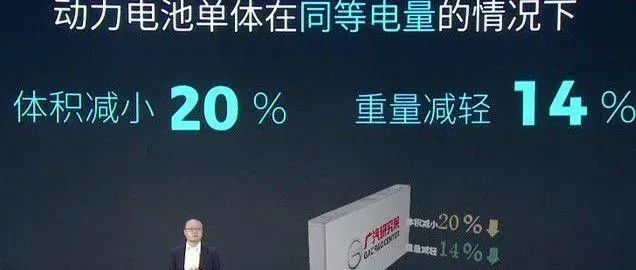Introduction: No false statements, only for the truth.
On January 18, 2021, GAC Group announced that graphene-based superfast charging batteries and long-lasting silicon anode batteries have been tested in actual vehicles as planned, and are expected to be installed on the existing AION V and AION LX models of GAC AION within this year. In response to the Weibo message released on January 15, it was emphasized that the graphene-based super-fast charging battery and the long-lasting silicon anode battery are two different battery technologies. On January 5, 2022, the AION LX Plus, which is equipped with a long-lasting silicon anode battery, was officially launched.
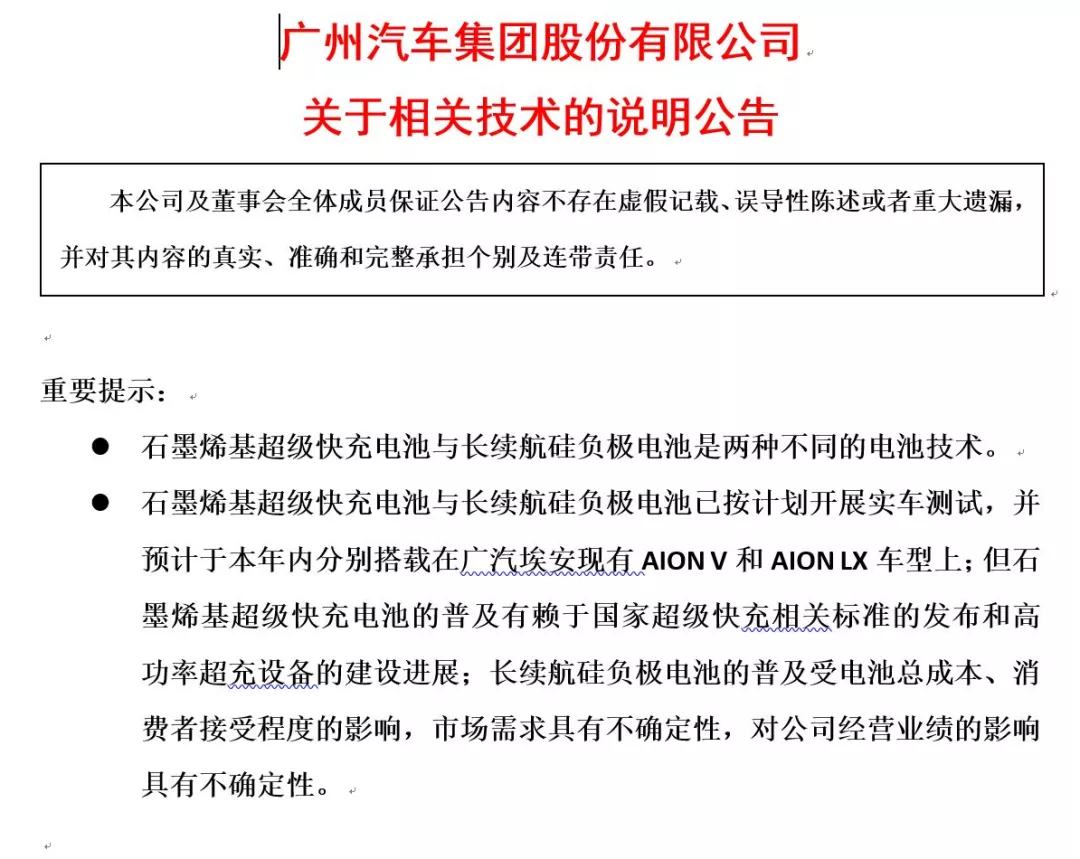
As of the end of December 2021, the official website of GAC AION shows that the AION LX series is still only equipped with ternary lithium-ion power batteries, with the highest configuration being the 80DMax version with a maximum range of 600km. In the AION V Plus series, the 70 superfast charging version is equipped with 10-minute superfast charging technology, which can achieve a battery capacity from 30% to 80% within 10 minutes, with a range of 500 km under working conditions.
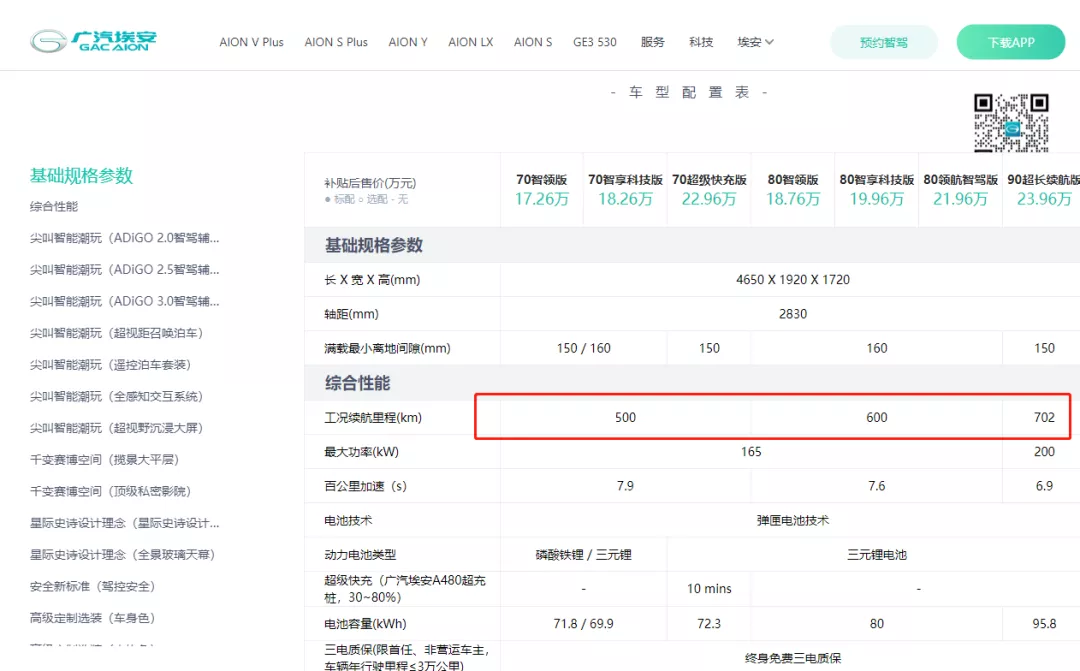
The data at the end of 2021 still lags behind the technical standards promoted by GAC AION. The so-called super-fast charging + ultra-long range + super safety, the graphene-based superfast charging battery claims to be able to fully charge 80% within 8 minutes, and the long-lasting silicon anode battery is the world’s first to break through the 1000km range barrier, with an NEDC range of 1008km. According to official information, in the summer heat test completed in Sanya in July 2021, the actual measured data with air conditioning on was 904km. At the same time, it can pass the most stringent safety tests and achieve military-level standards.
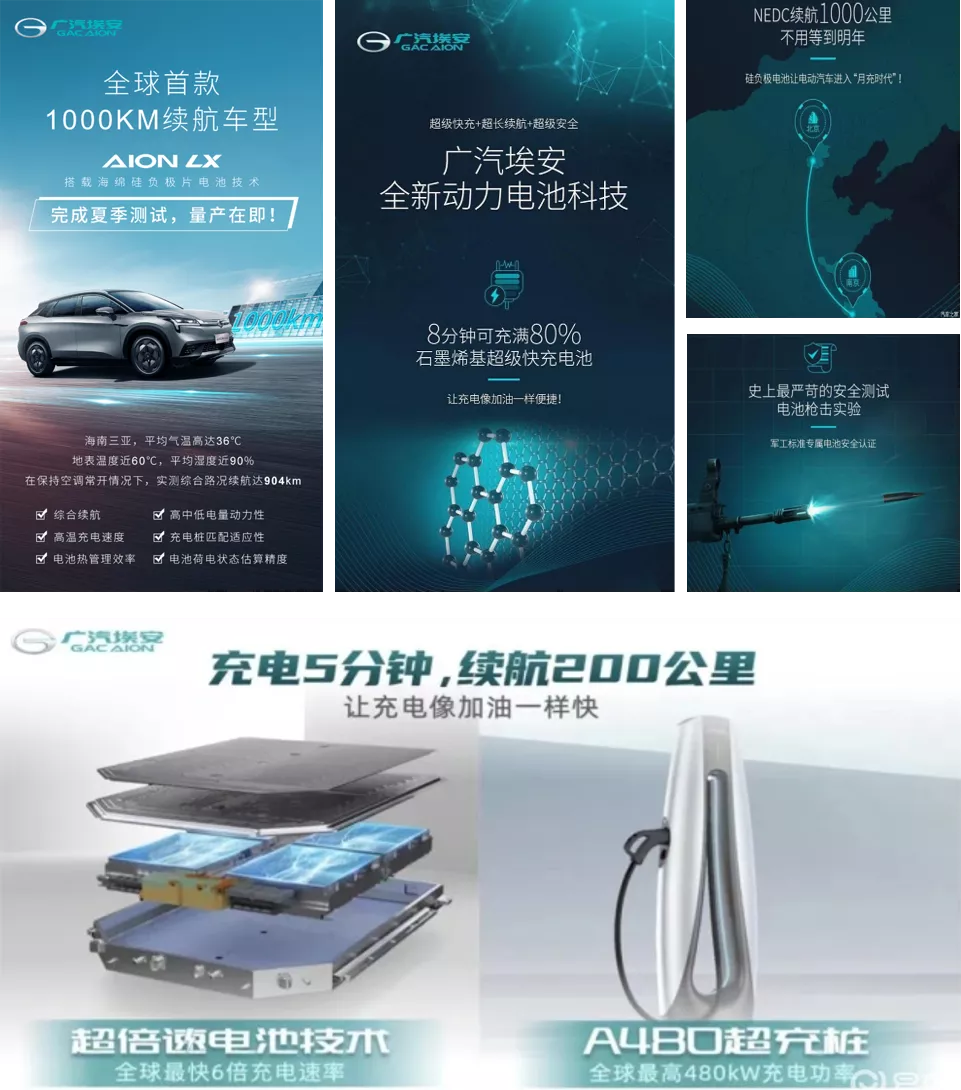 In January 2021, Ouyang Minggao, Vice Chairman of the China EV100 and academician of the Chinese Academy of Sciences, stated at the China EV100 Forum (2021) that “if someone says their electric vehicle can run 1,000 kilometers, be fully charged in just a few minutes, and is also particularly safe and has a very low cost, you don’t have to believe it, because it is currently impossible to achieve all of these at the same time.”
In January 2021, Ouyang Minggao, Vice Chairman of the China EV100 and academician of the Chinese Academy of Sciences, stated at the China EV100 Forum (2021) that “if someone says their electric vehicle can run 1,000 kilometers, be fully charged in just a few minutes, and is also particularly safe and has a very low cost, you don’t have to believe it, because it is currently impossible to achieve all of these at the same time.”
Therefore, the announcement by GAC Group at the beginning of the article claimed that the promotional content of the poster had been misread by everyone. Superfast charging and ultra-long battery life are not reflected in the same battery, but are two completely different technologies. As for the military-grade safety performance, no further explanation was given. With this announcement, people woke up to the fact that this was a PR game. It also intensified the public’s suspicion of the authenticity of the sponge silicon negative electrode battery technology.
However, amidst all the speculation, GAC Aion officially announced the launch of the GAC Aion LX Plus on the evening of January 5, 2022.
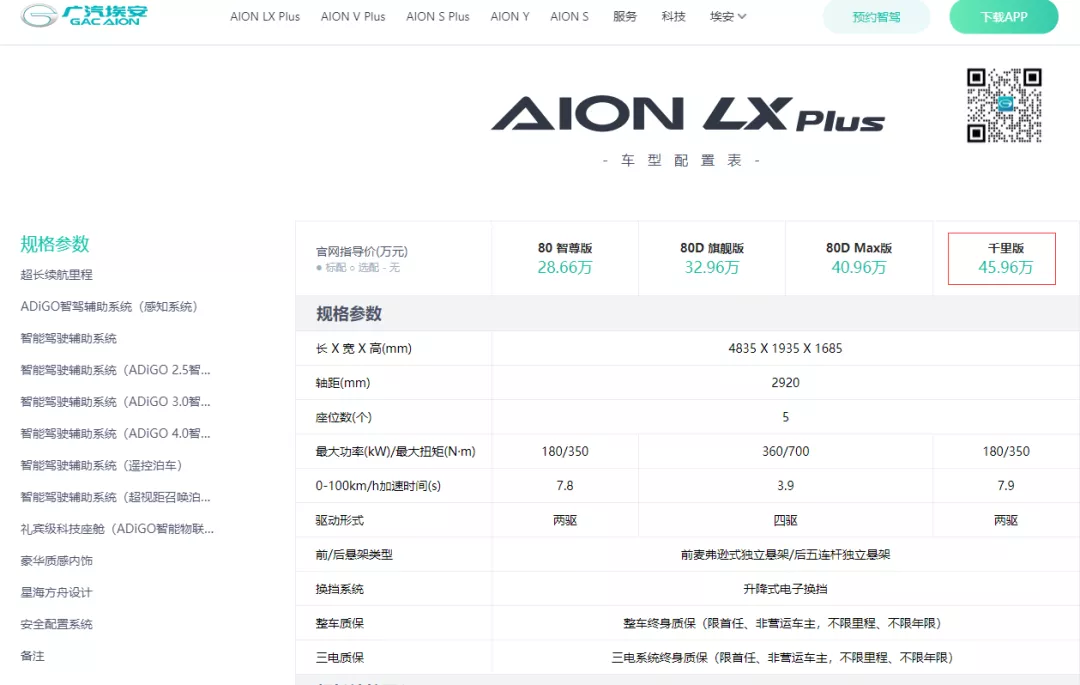

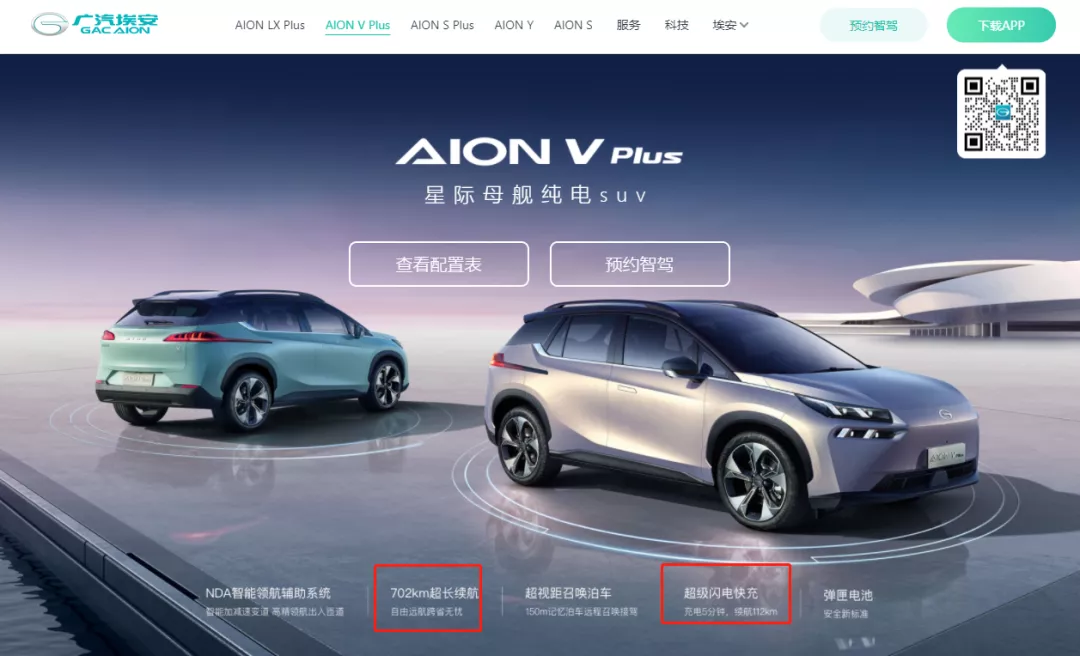
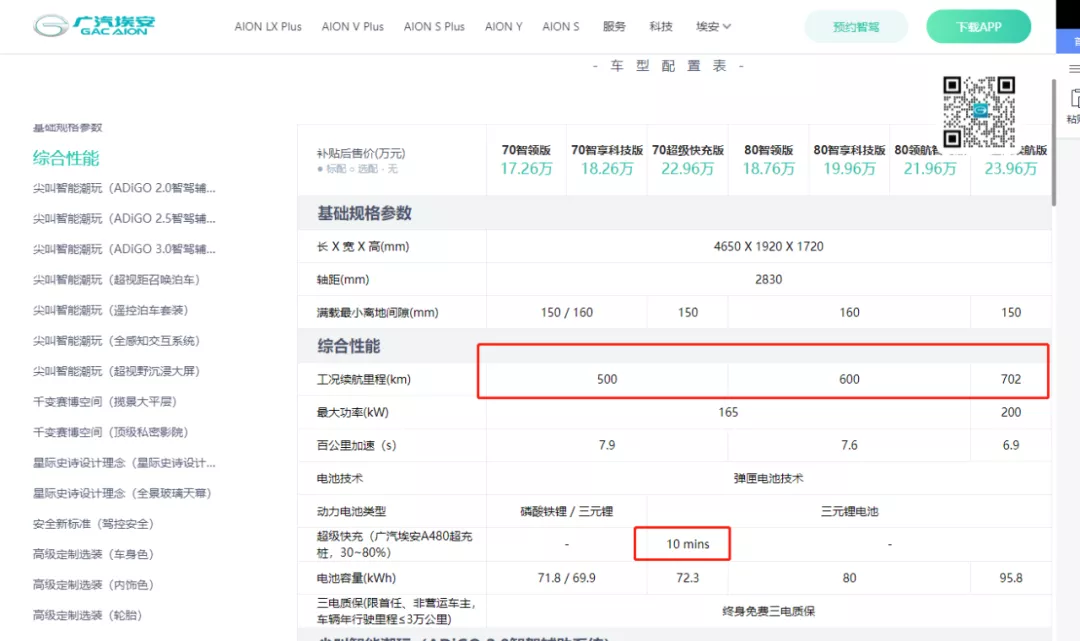
Among them, the top version, the “Thousand Miles Version,” is equipped with the much-discussed sponge silicon negative electrode battery, while other versions are equipped with the so-called military-grade safety standard magazine battery safety technology. As for the graphene-based superfast charging technology, which was previously advertised to be able to fully charge 80% of the battery in 8 minutes, it did not appear in this update. Even with the latest AION V Plus, which uses the super lightning fast charging technology, it can only achieve a 112km range in 5 minutes. For the entry-level model with a 500km range, it still takes 8 minutes to fully charge only 36% of the battery, which shows that it is not the graphene-based superfast charging technology that was previously advertised.
Therefore, let’s focus on the discussion of the silicon negative electrode ultra-long battery life technology in this heavy-duty new product release.
What is the negative electrode material?Here is a brief introduction to the working principle of lithium-ion batteries: lithium ions shuttle back and forth between the positive and negative electrodes, forming a highly reversible redox reaction system, which constitutes the charging and discharging process of lithium-ion batteries.
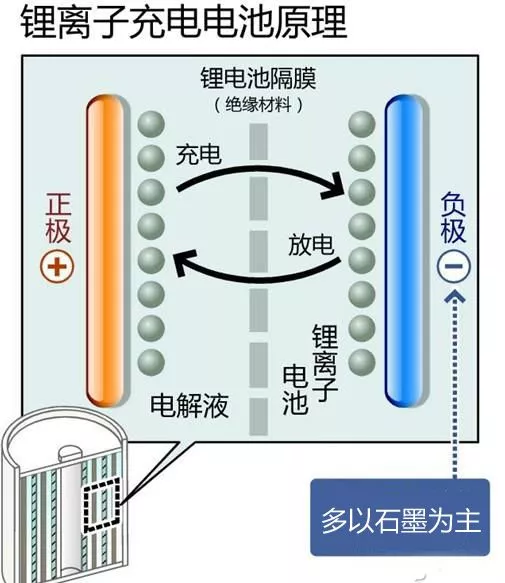
Therefore, the negative electrode material is like the “residence” for lithium ions during the charging process. In theory, if the positive electrode material can provide an unlimited amount of lithium ions, the higher the number of lithium ions that negative electrode material can accommodate, the higher the energy density and capacity of the lithium-ion battery under the same conditions. So the negative electrode is like the “warehouse” for storing and releasing energy of the whole battery. The larger the “warehouse”, the better the battery performance.
Silicon Negative Electrode with Unlimited Potential
Currently, there are two major types of negative electrode materials commonly used in battery materials: carbon-based materials and non-carbon materials.

From the application market point of view, graphite negative electrode materials are the most successful commercialized negative electrode materials. However, after years of research and technological improvement, the capacity of commercial high-end graphite negative electrode products can only reach 365 mAh/g, which is difficult to further improve. The low capacity can no longer meet the requirements of high energy density batteries, especially with the rapid development of consumer electronics and electric vehicles. Therefore, a new generation of high-energy-density negative electrode materials needs to be developed. Silicon, as the representative of the alloy reaction negative electrode material, is one of the most promising candidate materials for high specific energy negative electrodes.
In summary, silicon negative electrodes have the following advantages:
(1) The biggest advantage of silicon negative electrode materials is that their theoretical capacity can reach up to 4200 mAh/g, which is more than ten times that of traditional graphite materials and has a relatively low charge and discharge platform.
(2) The reaction activity of silicon negative electrode materials with the electrolyte is low, making it difficult to continuously generate a solid electrolyte interface film inside the battery, which effectively reduces the consumption of electrolyte and the loss of capacity. Based on this, the energy storage capacity of silicon negative electrode batteries can easily exceed 100 kWh, and achieving 1000 kWh in the future is also possible.
(3) Silicon materials have broad sources, abundant reserves, are non-toxic and environmentally friendly, and have been widely used in the fields of solar energy and semiconductor industry. Related development technologies are relatively mature, which greatly reduces their production costs. Therefore, silicon negative electrodes are recognized as the first choice for the next generation of high specific energy lithium-ion battery negative electrode materials in the industry.
As the mainstay of next-generation anode materials widely favored, silicon-based materials are currently being enthusiastically researched and tried out by numerous industry leaders such as CATL and BYD, while overseas companies like BTR have even achieved mass production of silicon-carbon anodes. However, according to public data, no business has actually accomplished large-scale production of long-life silicon anode batteries.
This is because although silicon anode materials have high theoretical capacities, they currently face three major issues:
(1) The volume expansion after lithium insertion in silicon can reach 300%-400%, causing the pulverization of active electrode materials and damage to crystal lattices. Furthermore, it results in the detachment of silicon materials from conductive agents, decreasing conductivity and causing electrochemical inefficiency, leading to rapid capacity attenuation and deterioration of cycle life. At the same time, the huge volume expansion causes the SEI film to be repeatedly damaged and regenerated, accelerating electrolyte degeneration and consumption, leading to the decrease in Coulomb efficiency. The immense volume change can also cause larger swelling and cracking of the electrode membrane, resulting in active materials falling off the current collector, thereby increasing the battery’s internal resistance, adding to the amount of heat output, and causing serious safety risks.
(2) Poor conductivity of silicon and slow lithium-ion diffusion. The electrical conductivity of silicon is 10^-3 S/cm, and the ion diffusion coefficient is 10^-12 cm^2/s. The low electronic conduction and ion diffusion result in sluggish kinetics, reduction of active material utilization, and ultimately causing severe capacity attenuation. Additionally, slow kinetics cannot ensure normal charging and discharging under high current densities, leading to poor rate performance.
(3) The preparation process is more complicated and expensive. Currently, the high production costs and complex technological processes of silicon anode make its rapid development impossible. Therefore, reducing production costs, simplifying the production process, and strengthening environmental protection in production are pressing issues that need to be resolved in the widespread application of silicon anode materials.
Issues Faced by Silicon Anode Materials
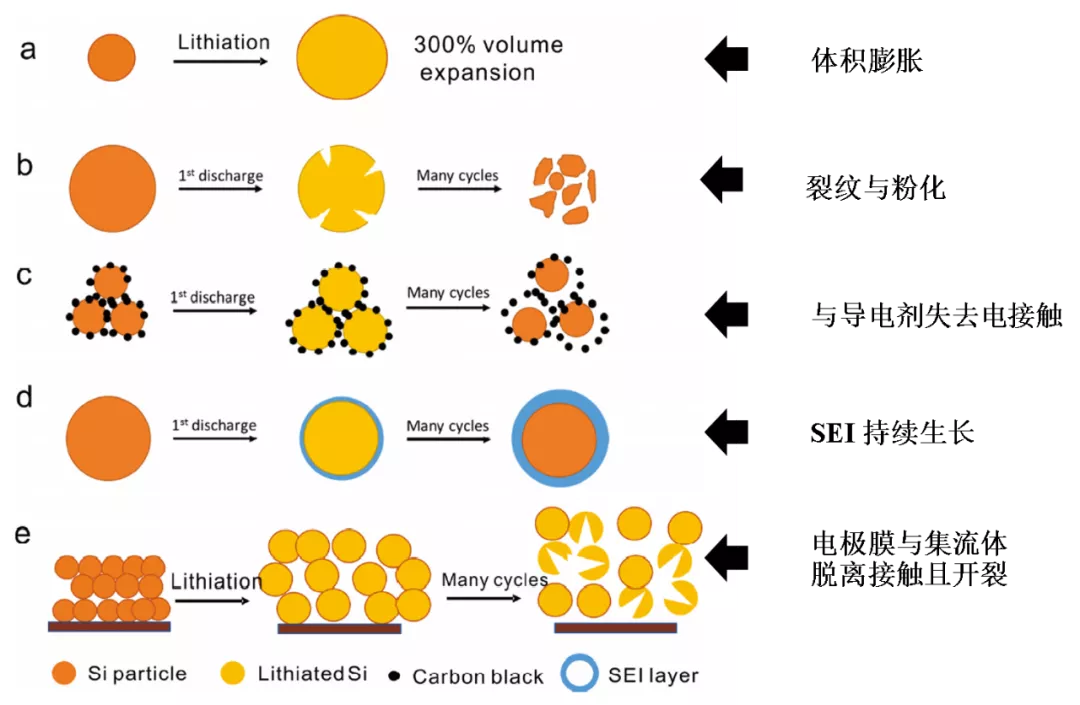 The fatal flaw of the silicon anode in lithium-ion batteries is its volume expansion of up to 300%-400%, which occurs during lithiation. That is the reason why silicon-based anodes have not been widely used in lithium-ion batteries since their discovery in 1966, as the expansion rate leads to structural instability and subsequent collapse of the electrode, resulting in poor performance and low usable capacity, according to the literature (Beaulieu et al. 2001, Ryu et al. 2011, Zhao et al. 2011a).
The fatal flaw of the silicon anode in lithium-ion batteries is its volume expansion of up to 300%-400%, which occurs during lithiation. That is the reason why silicon-based anodes have not been widely used in lithium-ion batteries since their discovery in 1966, as the expansion rate leads to structural instability and subsequent collapse of the electrode, resulting in poor performance and low usable capacity, according to the literature (Beaulieu et al. 2001, Ryu et al. 2011, Zhao et al. 2011a).
The issue can be analyzed from two perspectives: mechanics and chemistry.
From a mechanical perspective, the continuous increase in volume during charging, caused by the insertion of lithium ions into the material, generates high internal stress, leading to deformation of the silicon-based anode. At around 325 mAh/g, the internal stress of the anode reaches approximately 1.7 GPa, causing plastic deformation. At 1875 mAh/g, the stress drops to around 1 GPa. During battery discharge, when the lithium deinsertion process is initiated, the anode undergoes elastic deformation, and the stress state rapidly changes from compression to tension. At around 1 GPa of tension stress, the material begins to undergo plastic deformation, and the ultimate tensile stress can reach about 1.75 GPa.
In short, the stress fluctuations due to volumetric expansion during charge and discharge result in the continuous destruction of the silicon-based anode, leading to a lower actual capacity after the initial charge-discharge cycle. The silicon anode can be visualized as a lithium-ion “warehouse” that is initially packed tightly with goods, causing the structure to expand. When lithium ions are extracted, the abrupt change from compression to tension stress and the sustained stress cause the structure to fail, leading to cracks and ultimately fragmentation.
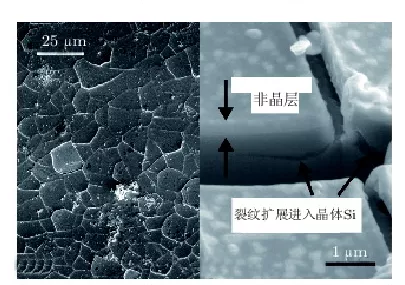
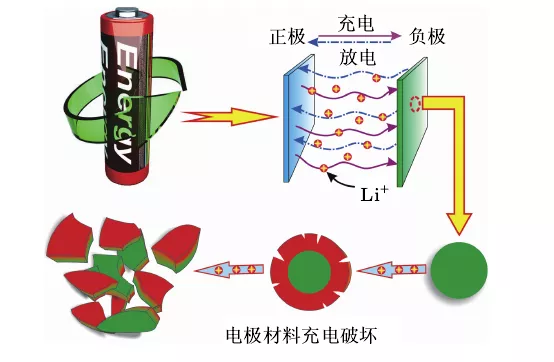
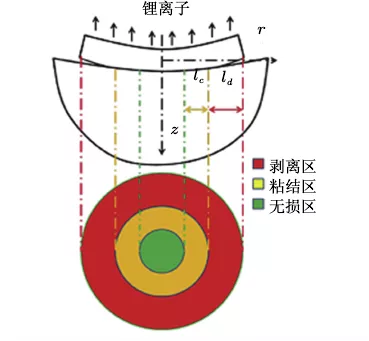
Based on stress analysis, many scientists adopt a more intuitive approach by directly observing the failure behavior of nano silicon technology in the process of charge and discharge using high-magnification electron microscopes. As the charging time increases, the solid electrolyte (SEI) membrane on the outer layer of the nano-silicon particles begins to break down. Later, cracks appear on the inner layer of the silicon particles. Finally, when the diameter of nano silicon particles exceeds the critical size of D=150nm, the particles will fail and disintegrate.
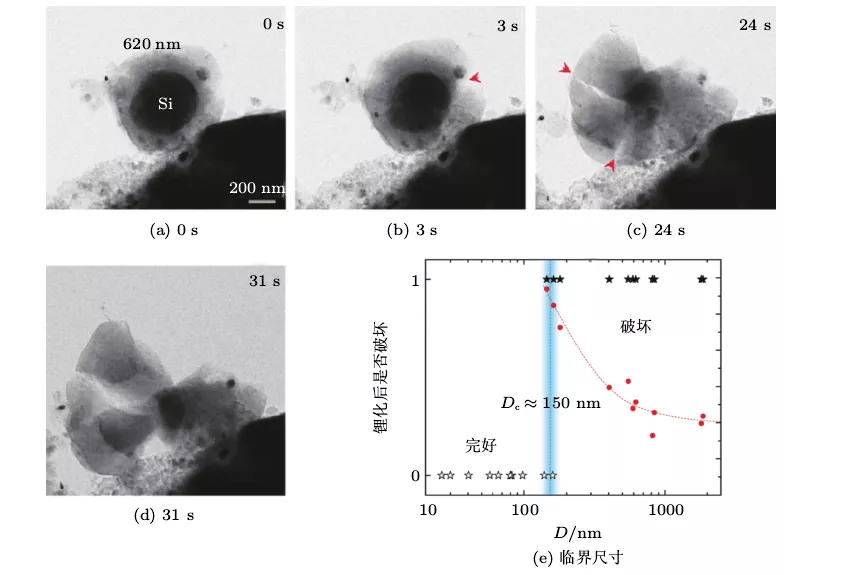
Simply from the perspective of chemical structure, during charging and discharging, as the lithiation process progresses, the lattice structure of silicon will be rearranged due to the embedding of lithium ions. Many Si-Si bonds will break, while Si-Li bonds will continue to form, allowing the material to accommodate more lithium ions. As a result, the material will undergo plastic deformation. Due to the difference in average bond length between Si-Li bonds (2.78Å) and Si-Si bonds (2.45Å), the bond length inside the material changes, the atomic coordination number decreases, the atomic radius shrinks, and the binding energy is reduced, ultimately leading to a decrease in the strength of the silicon negative electrode material.
From an electrochemical perspective, the cracking of the silicon negative electrode material leads to the continuous breakdown and generation of the solid electrolyte (SEI) film on its surface, consuming lithium ions in the electrolyte and increasing the thickness of the solid electrolyte film. The excessively thick SEI film hinders electron transfer and lithium ion diffusion, and impedance also increases.
What are the highlights of GAC Group’s sponge silicon negative electrode battery technology? How does it solve current problems?
As the name suggests, the characteristic of sponge is that it expands when absorbing water, but shrinks back to its original size after draining the water, without excessively expanding or even bursting. According to GAC Research Institute, the sponge silicon negative electrode battery technology is a technical group involving fields such as battery cathode and anode materials, binders, electrode design, and process production. The core principle of sponge silicon negative electrode battery technology is to make the silicon negative electrode inside the battery soft and elastic like a sponge, so that the expansion and contraction of silicon during charge and discharge can be limited and buffered, and it will not crack. At the same time, it enables the silicon negative electrode to take advantage of its high capacity, like sponge absorbing water, to store more energy.
This technology overcomes the application difficulties of silicon negative electrode materials in large-scale power batteries, mainly including:(1) “Nano-composite silicon technology”. This technology controls silicon material on the nanoscale and coats it with a protective layer on the surface to control micro morphology and minimize volume expansion of silicon during charging and discharging processes. The surface coating also avoids direct contact between silicon and electrolyte, improving the stability of the interface.
(2) “Self-healing adhesive technology”. The adhesive in the anode is modified and optimized to have excellent envelopment, adhesion, and resilience properties, which repairs the damaged silicon anode during expansion and contraction processes, ensuring the stability of the electrode structure.
(3) “Gradient composite coating technology” greatly enhances the binding force between the active component and non-active buffering component of silicon anode by designing gradient distribution, improving the structural stability of the anode. This technology lets the silicon material expand during charging and discharge process in a “buffered” way.
Guangzhou Automobile Group announced that through this group of sponge-like silicon anode battery technologies, the volume of a power battery unit can be reduced by 20%, the weight can be reduced by 14% while maintaining the same energy capacity. The energy density of the battery unit can reach 280Wh/kg, which allows more batteries, more electricity storage, and faster charging under the same and cramped vehicle chassis space. Therefore, the AION LX electric vehicle model equipped with sponge-like silicon anode battery technology can achieve a range of 1000 km.
From the information known at present, in the world-wide silicon anode range competition, Guangzhou Automobile Group is a black horse, successfully announcing the mass production of a 1008km NEDC range, 144.4 kWh capacity battery in the global market, achieving the world’s first production of this kind of battery technology, which is undoubtedly an exciting new battery technology.
In response to some problems caused by silicon anodes, the academic community has taken corresponding measures, but they are only at the laboratory level. For example, in a paper entitled “A robust network binder via localized linking by small molecules for high-areal-capacity silicon anodes in lithium-ion batteries” published in the international authoritative journal “nano energy” (IF=17.88) in 2020, ZeHeng Li and others from Zhejiang University reported an adhesive that can be used in high-capacity silicon anodes of lithium-ion batteries by locally connecting small molecules to suppress volume expansion.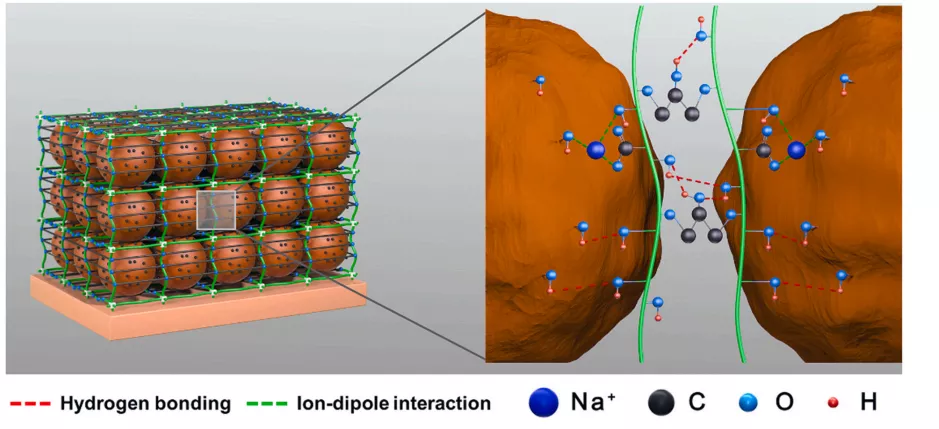
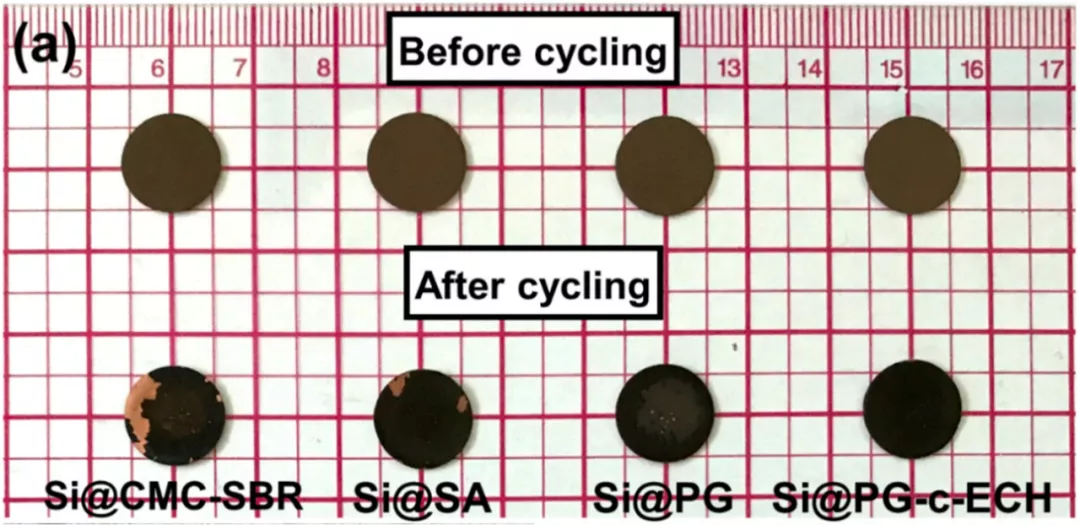
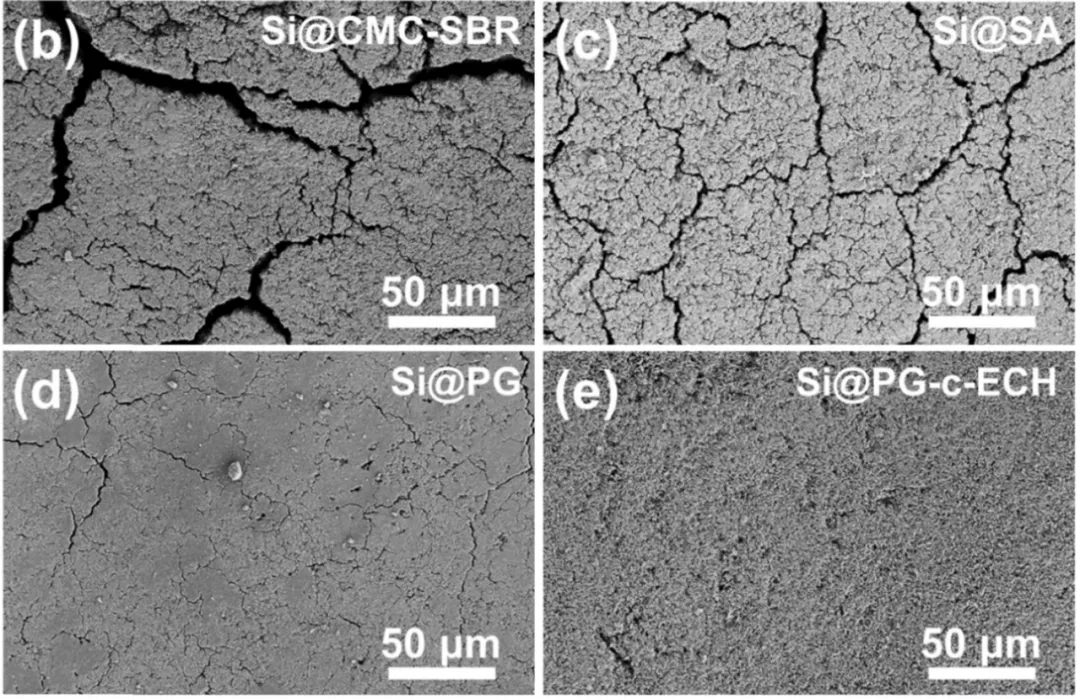
The newly developed PG-c-ECH adhesive applied in silicon negative electrode materials by the research team maintained a capacity of 2060mAh g-1 after 200 charge and discharge cycles, which is about 50% of the theoretical capacity of silicon negative electrodes.
As research data that can be published in international authoritative journals, it largely represents the current research level of the domestic academic community, although the academic community is generally recognized to lag behind commercial application research. But this study still differs significantly from the data released by GAC.
As for a small detail that one can compare, according to the document “Catalog of New Energy Vehicles Exempted from Vehicle Purchase Tax (Batch 48)” released by the Ministry of Industry and Information Technology (MIIT), the total mass of the power battery pack of the AION LX model with a 1008km working condition cruising range from GAC Aion is 690kg, and the total energy of the power battery pack is 144.4kWh. Therefore, the energy density of its battery system should be 144.4kWh/690kg, approximately equal to 0.2093kWh/kg (rounded up), or converted to 209.3Wh/kg. However, the data promoted by GAC Aion’s official WeChat post is 205Wh/kg. Although the difference is small, it still raises the question of whether it is due to inaccurate promotion or some other reason.
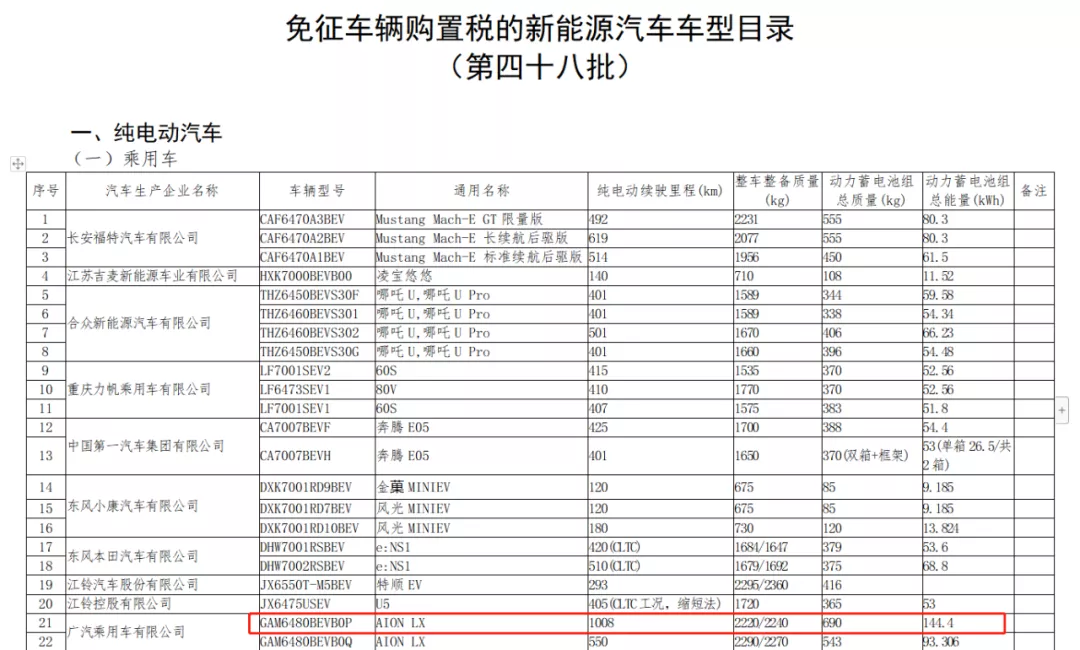 Moreover, let’s talk about the endurance mileage. According to the NEDC endurance test shown on its poster, the author checked Wikipedia and found that NEDC was conceived for lighter and weaker-powered vehicles in Europe and was originally designed as a standard for fuel-powered vehicles. The test provides a formulaic driving speed mode with low acceleration, constant cruising and many idle events. However, in practice, acceleration is much steeper, partly due to the excessive power of modern engines, as the average time from 0 to 100 km/h (0 to 62 mph) decreased from 14 seconds in 1981 to 9 seconds in 2007. Therefore, the so-called 1008km endurance under the standard test conditions remains questionable with its actual measured endurance of 904km.
Moreover, let’s talk about the endurance mileage. According to the NEDC endurance test shown on its poster, the author checked Wikipedia and found that NEDC was conceived for lighter and weaker-powered vehicles in Europe and was originally designed as a standard for fuel-powered vehicles. The test provides a formulaic driving speed mode with low acceleration, constant cruising and many idle events. However, in practice, acceleration is much steeper, partly due to the excessive power of modern engines, as the average time from 0 to 100 km/h (0 to 62 mph) decreased from 14 seconds in 1981 to 9 seconds in 2007. Therefore, the so-called 1008km endurance under the standard test conditions remains questionable with its actual measured endurance of 904km.
In addition, unlike the previously announced NEDC endurance of 1000 kilometers by GAC Aion, most media reports now publicize the CLTC endurance, which claims to measure higher-endurance data than the NEDC standard. However, the detailed configuration on GAC Aion’s official website only displays the endurance under test conditions without specifying whether it is NEDC or CLTC endurance.
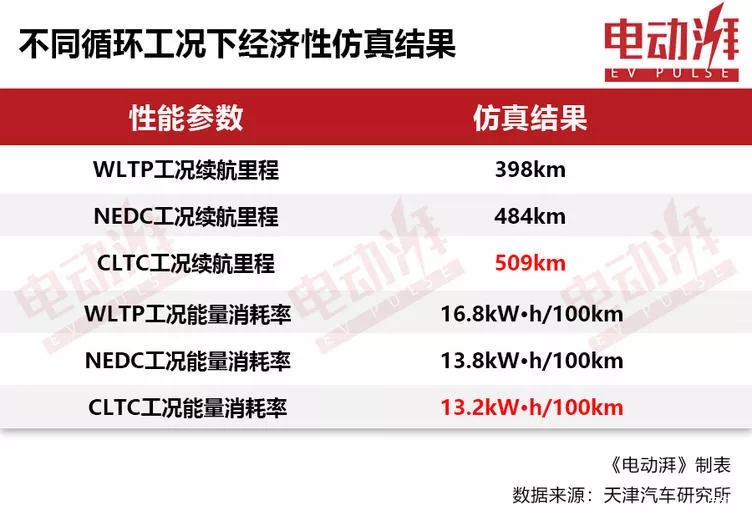
Among them, the endurance mileage of this model is only 398km under WLTP conditions, 484km under NEDC conditions, and as high as 509km under CLTC conditions.
Furthermore, there is one point worth noting. GAC Aion’s promotion does not mention the lifespan issue of the silicon negative electrode battery technology. As analyzed earlier, a fatal weakness of silicon negative electrode batteries is poor cycle performance and short lifespan. Therefore, can this endurance of 1,000 kilometers be maintained for a long time?
In the end, the sponge silicon negative electrode battery technology is just replacing the battery cell. The most critical point is energy density. GAC Aion’s battery cell energy density is less than 300 Wh/kg, which is far from the current advanced batteries. Meanwhile, battery management technology needs to be improved. The theoretical endurance of the 144kWh car is only 1000 kilometers while Tesla’s battery management technology can already achieve an actual endurance of 1000 kilometers.According to the publicly accessible website of China Patent Publication Announcement, Guangzhou Automobile Group (GAC) has been conducting research and development on new energy battery technology for many years. Significant breakthroughs have been made in improving and optimizing the performance of silicon materials, hybrid composite technology of negative electrode materials, new types of binders, new electrolytes, and novel battery pole piece designs. A large number of patents have been applied for. However, from theory to practice, market validation is still required. Therefore, despite the fact that the Aion, equipped with this technology, has already been launched into the market, based on current data, the author remains skeptical about the authenticity of this technology. A substantial amount of data from actual tests is needed to support the sponge silicon negative electrode battery technology.
However, the GAC Aion still knows the needs of the Chinese people best. The supercharging technology combined with extended endurance is undoubtedly the future trend of electric vehicle development.
References:
[1] GAC Aion Official Website. AION LX Detailed Configuration. [OL] https://www.gacne.com.cn/vehicles/aion_lx
[2] How to evaluate AION LX equipped with 1,000km sponge silicon negative electrode battery technology on GAC Aion? [OL]. Zhihu, 2021. https://www.zhihu.com/question/471274223/answer/2214668588
[3] Ma Z S, Zhou Y C, Liu J, et al. Mechanical Progress in Research on the Decline Mechanism of Silicon Anode Materials in Lithium-ion Batteries [J]. Advances in Mechanics, 2013.
[4] Kai W M. Research on High Capacity Silicon-based Negative Electrode Materials for Lithium-ion Batteries [J]. New Era Securities Research Institute, 2020.
[5] Li Z, Wan Z, Zeng X, et al. A Robust Network Binder via Localized Linking by Small Molecules for High-Areal-Capacity Silicon Anodes in Lithium-ion Batteries [J]. Nano Energy, 2021, 79: 105430.
[6] New European Driving Cycle. [OL]. Wikipedia. 2012. https://en.wikipedia.org/wiki/NewEuropeanDriving_Cycle
[7] An W L. Design, Synthesis and Lithium Storage Properties of Porous Micron-sized Silicon-based Negative Electrode Materials [D]. Wuhan University of Technology.
This article is a translation by ChatGPT of a Chinese report from 42HOW. If you have any questions about it, please email bd@42how.com.
